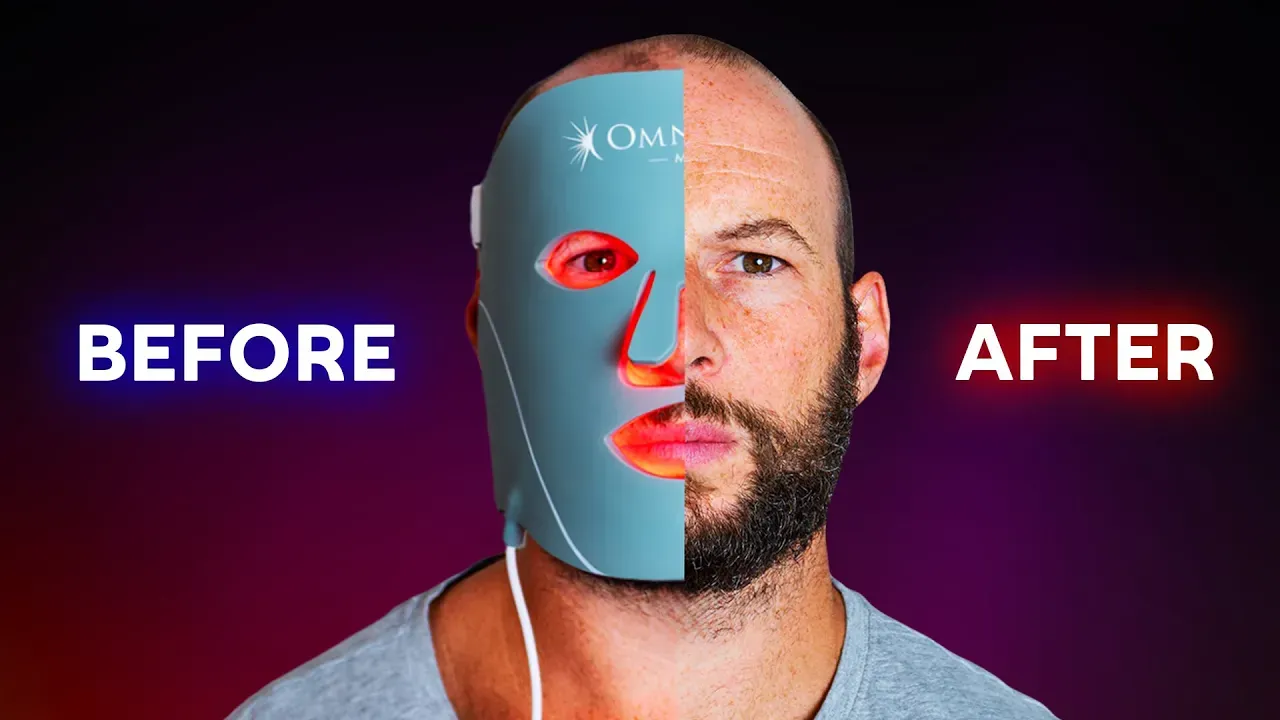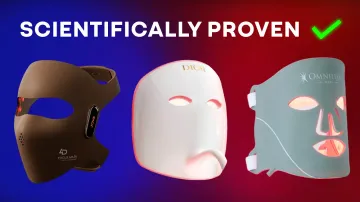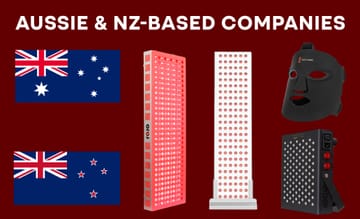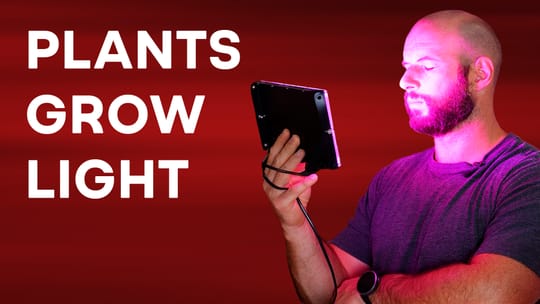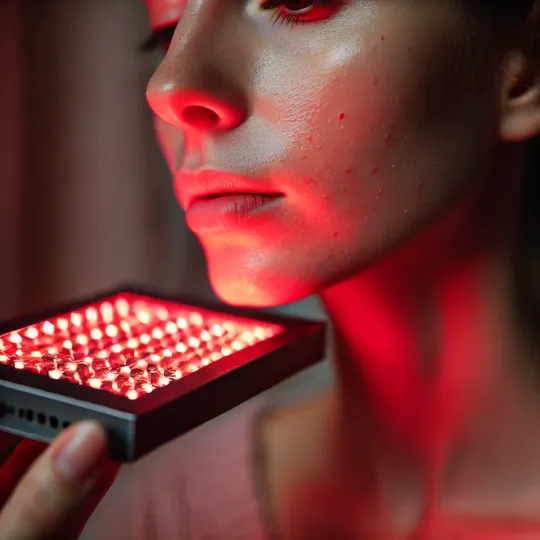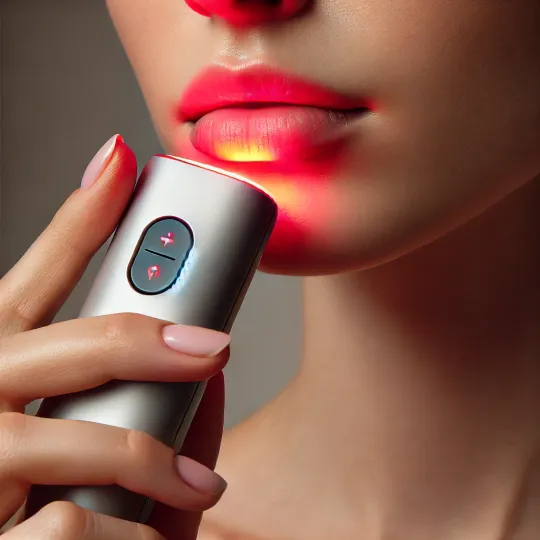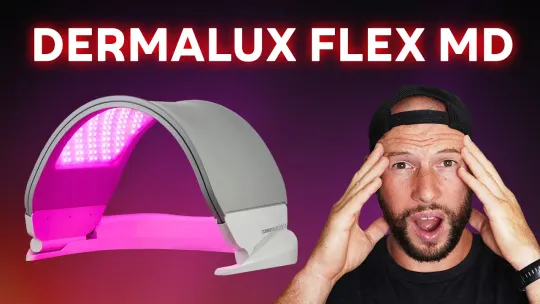You've probably seen LED masks advertised for optimizing skin health, but do they really work? Well, I tried the brand new Omnilux men's mask from Omnilux LED that just hit the market.
This is a red light therapy mask designed to improve skin health. The company behind this has been quite popular especially in the beauty space. They launched this particular product last year. It's called the Omnilux Men.
I read the FAQ the frequently asked questions section on this product, and one of the person asked, "Can it be used by a woman?"
My thoughts are, "Yes, of course!"
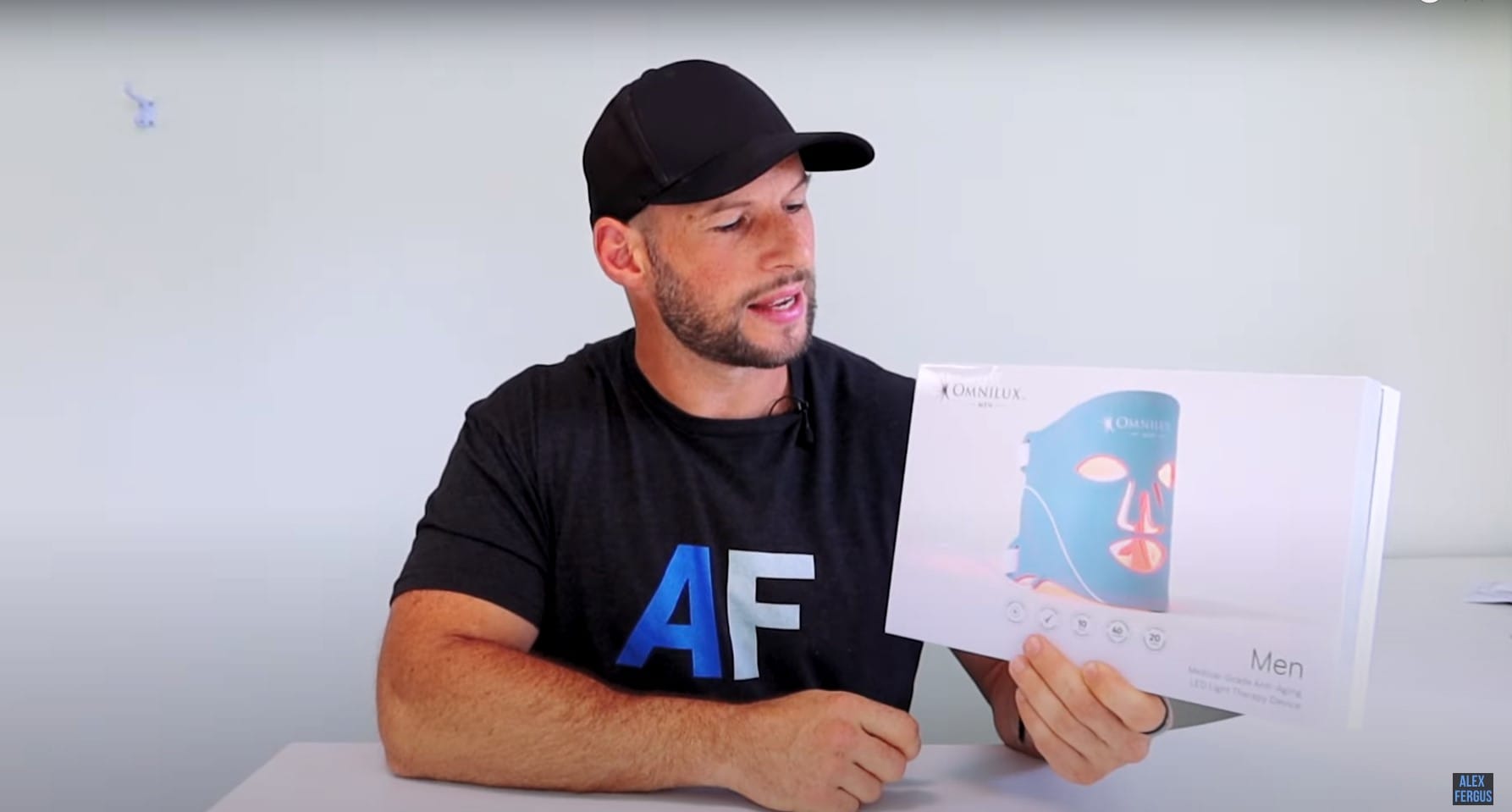
I am highly experienced when it comes to red light therapy since I have reviewed and tested a lot of red light therapy products overall, yet this is only the second mask I have used and reviewed so far.
Traditionally, I've tested and reviewed red light therapy panels: full body size, tabletop size, and even smaller ones including handheld devices. Recently, I've started looking at other red light therapy products such as, helmets, joint-targeting devices, belts, and now masks.
I looked at a Dermabeam mask last year. It was in the comments from that video where someone asked me to check out Omnilux.
They said, "Hey look, these guys are big players!" I did some research, and yes that comment was right on the money because this company is well known in the in the beauty space for their red light LED masks.
They've got rave reviews. The company is doing great. People swear by it, so the products obviously work. I'm not surprised that people are writing positive reviews because we know red light therapy works. We know it's amazing for health, wellness, and recovery. So, I can understand why these masks are so popular.
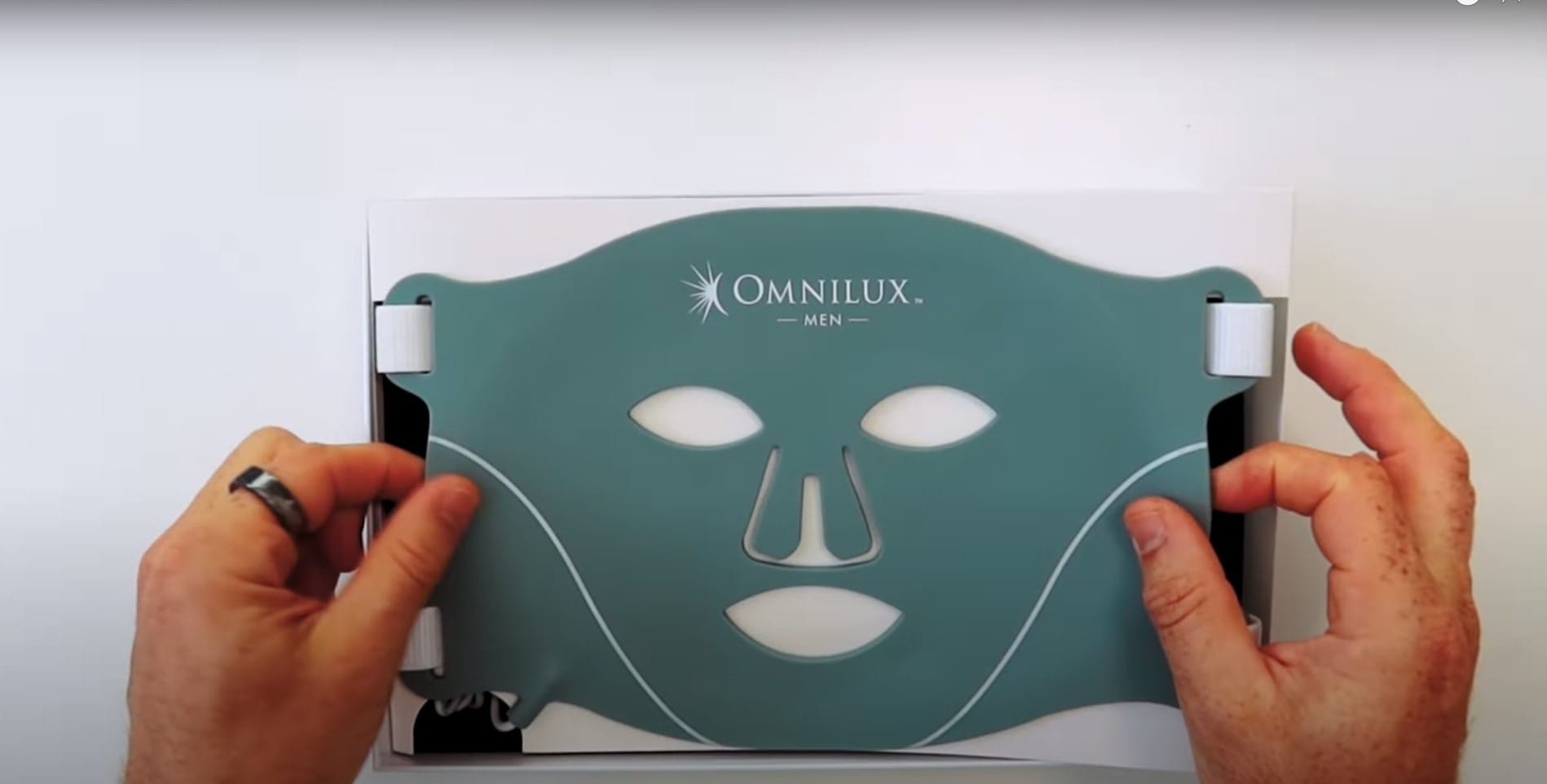
We're going to run through the key information, take a look at its features, discuss the scientific benefits, and see how it performs in my N= 1 experiment.
I tried it out for five weeks to see if it helped me. Not only that, I actually covered up half of the mask to see if it would make a difference to one side of my face. And I will be sharing my before and after photo.
Unboxing the Mask & Accessories
Before I get into evaluating the wavelengths and whether they're optimal, we're going to open the box and have a look at how it runs.
On the front of the box, it says that it's a dermatologist-approved, FDA-cleared product with a 10 minute treatment time based on over 40 peer-reviewed studies and 20 years of continuous research.
On the back, we have a bit of an explanation about the reduction of fine lines, wrinkles, redness, having healthier skin, what's included, and their warnings.
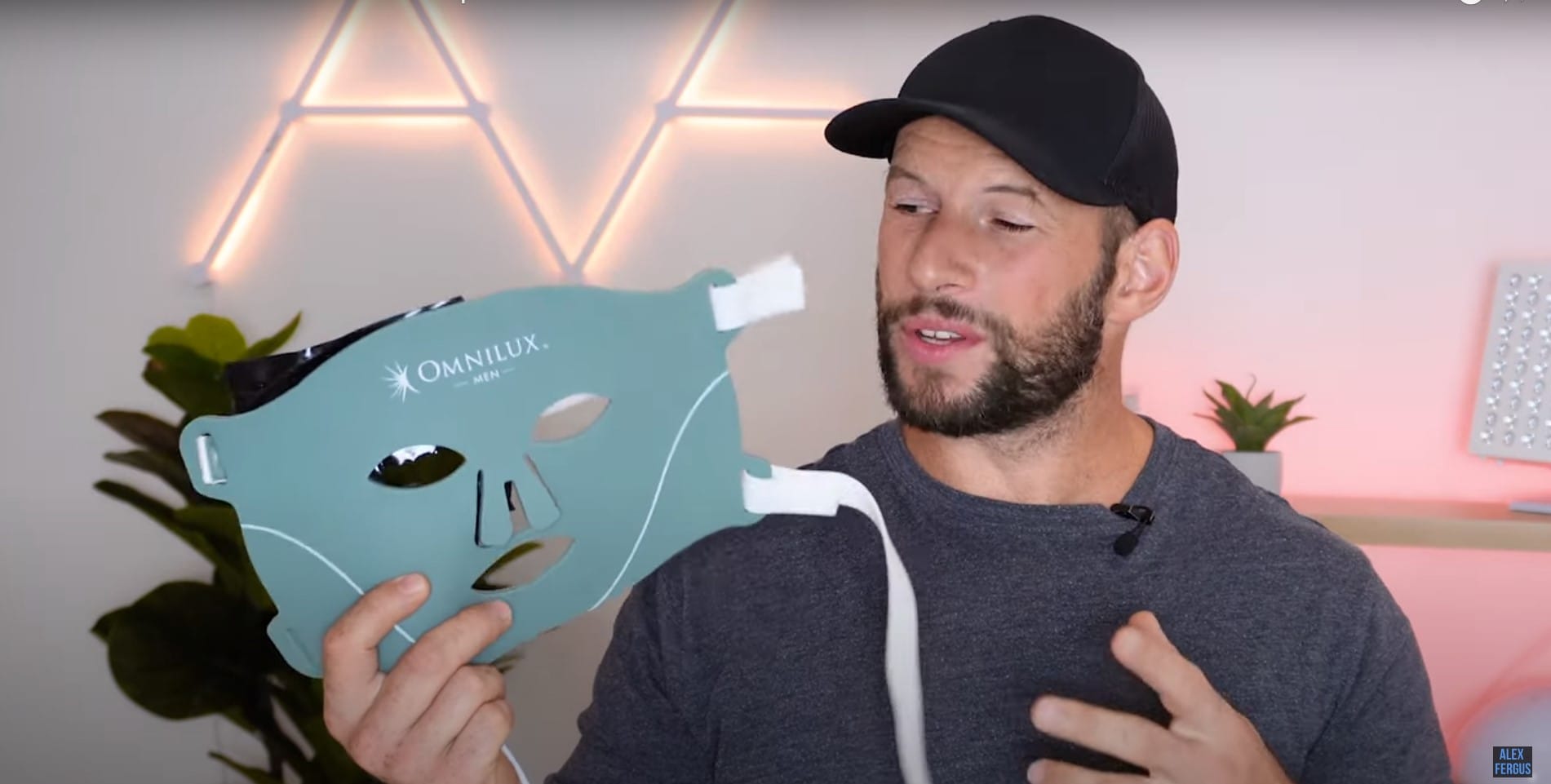
It is a silicone mask that is quite soft. It looks rather funny doesn't it? But it's nicely packaged. I suppose for $400, you want a nice package.
We have a step-by-step instruction guide with some interesting info in here. It says the mask is hands-free and completely portable. You can use it while doing other activities such as reading a book, cleaning, or watching TV.
It talks about how as our skin ages, it starts to wrinkle, sag, thin by 20—80% and dry out. Therefore, the younger you are, the thicker your skin. Plus, men's skin is thicker than women's. The 1072 wavelength is good at penetrating deeper into younger skin and men's skin.
We get a nice little storage bag, and then we've got a bunch of cables and adapters. The adapters are useful to me because I live in New Zealand and need that type of charging port.
There's a USB cable coming out of the side. It is a USB-C charging port for the control box. So you don't really need this if you've got your own charger.
Before you use it, charge it. It has three indicator lights. When it's fully charged, pull the cable out and plug it into the controller.
Product Features
Let's come back and look at the mask itself. First, let's look at the specs. There are 66 LED bulbs in here. Each bulb has two LED diodes. So that brings it to 132 LED diodes.
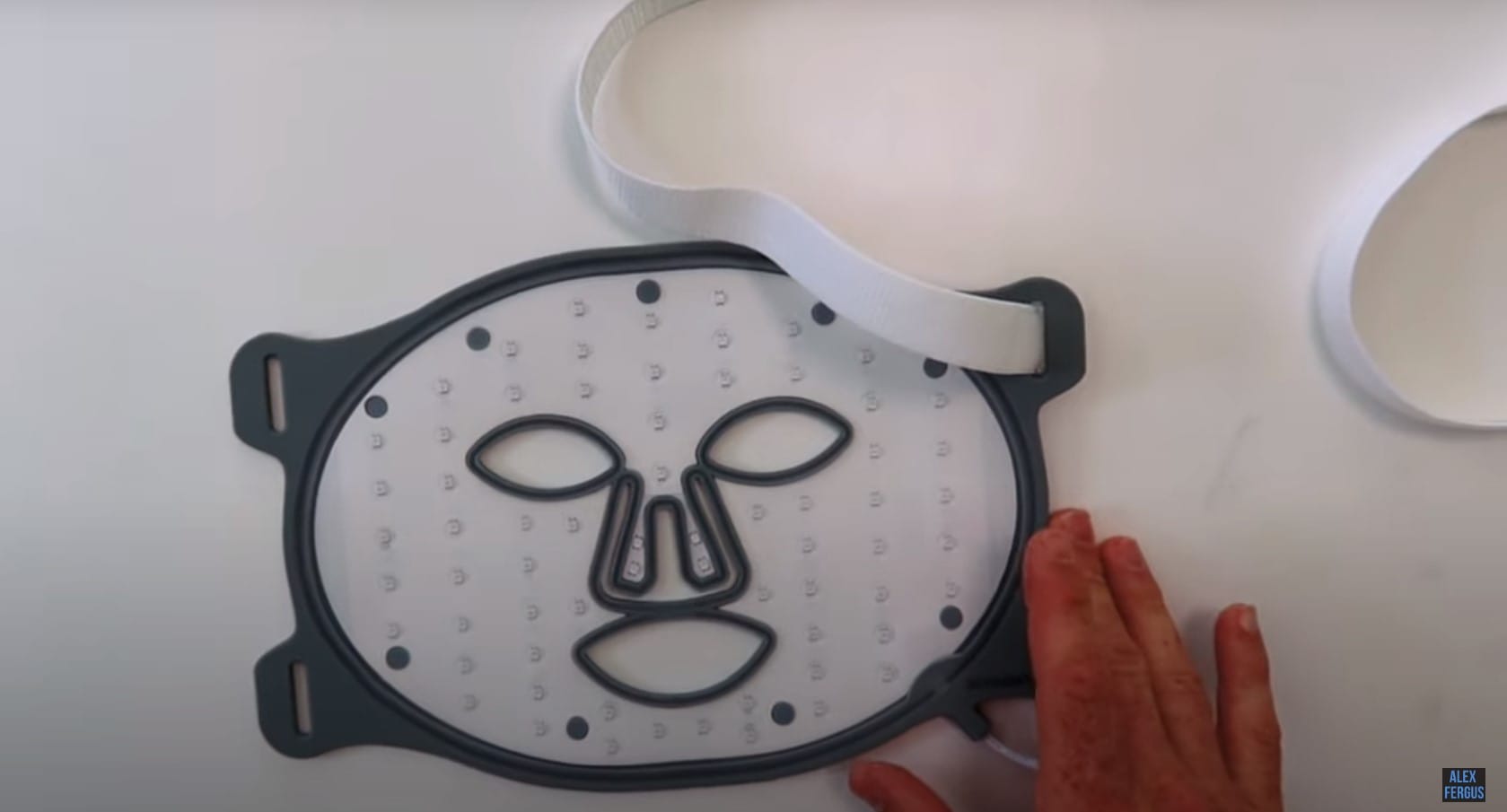
They're not as densely packed as we've seen in some other silicone LED wrap products.
For comparison here, I've got the Mito Red light therapy belt which I've reviewed. I'll put a link to that below if you want to check it out. Now you can see here how densely packed the LEDs are on this belt.
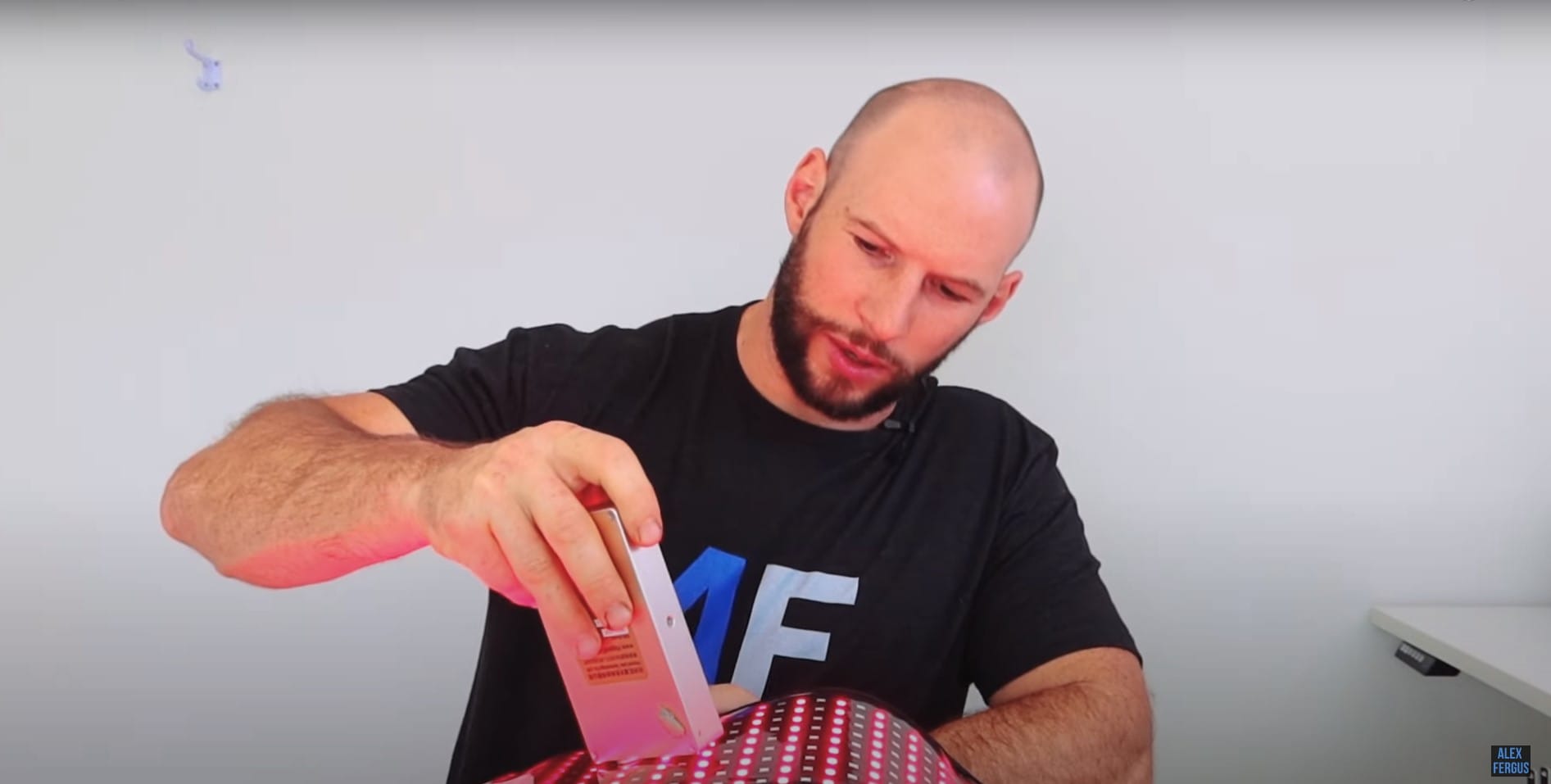
Within a square inch spacing, you're probably getting three LEDs. Whereas with this mask, you're only getting about two.
So you've got eye holes, a mouth hole, little flaps for either side of your nose which is good. It is well designed. You can tell it's a high quality product and a lot of thought has gone into it.
Now the only other mask I've tested was the Dermabeam mask. That one didn't have a cable. It actually had the battery unit and the control panel built into the mask, so this Omnilux mask is a little bit different.
Mask First Try
I'm going to put it on now for the first time. I know if I really need to wear it with its second strap as well, but I'll use it for now.
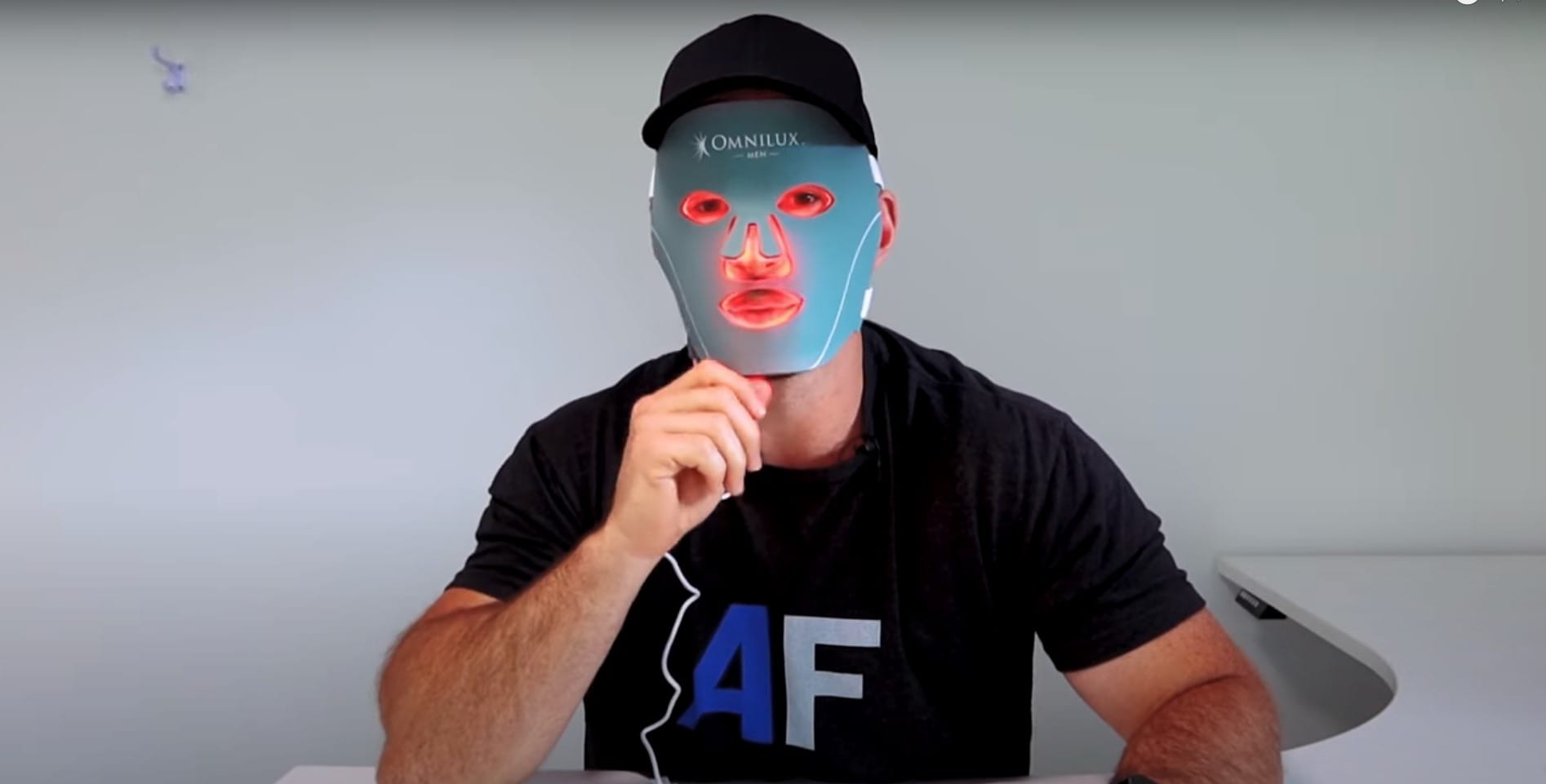
Gosh, I look like I'm about to rob a bank or something. LOL!
There's a bit of an unpleasant smell. I'm sure that will disappear with time. Just insert the cord, press and hold the button, and we have therapeutic red light!
My initial feedback is that I can easily see. I could read with this on. In fact, I may do some reading while I have it on here. I could clean up and do the dishes and whatnot. It's quite comfortable as well.
I could easily unhook this unit and keep it in my pocket so that it's not just dangling around. There's plenty of cord, but there's no clip on this. So if you don't have a pocket, I'm not too sure what you'd do. It's not too heavy though. I can move around easily. Also, the silicone is a good material for flexibility.
Is This Mask Gender Neutral Or Not?
You're probably wondering how does this "Men" mask differ to their regular LED mask. So that was the first question I had for for the Omnilux team when I was communicating with them.
They came back with this statement:
"Hi Alex, We know that men's skin is about 25% thicker on average than women's. For this reason, we've created an LED mask (this one) specifically for men's unique skin concerns that includes an added wavelength light of 1072 nanometers near infrared light to penetrate through a thicker skin barrier. We're very excited to bring this to the market!"
This particular version is different from the female version of their Omnilux Contour FACE which is their standard product.
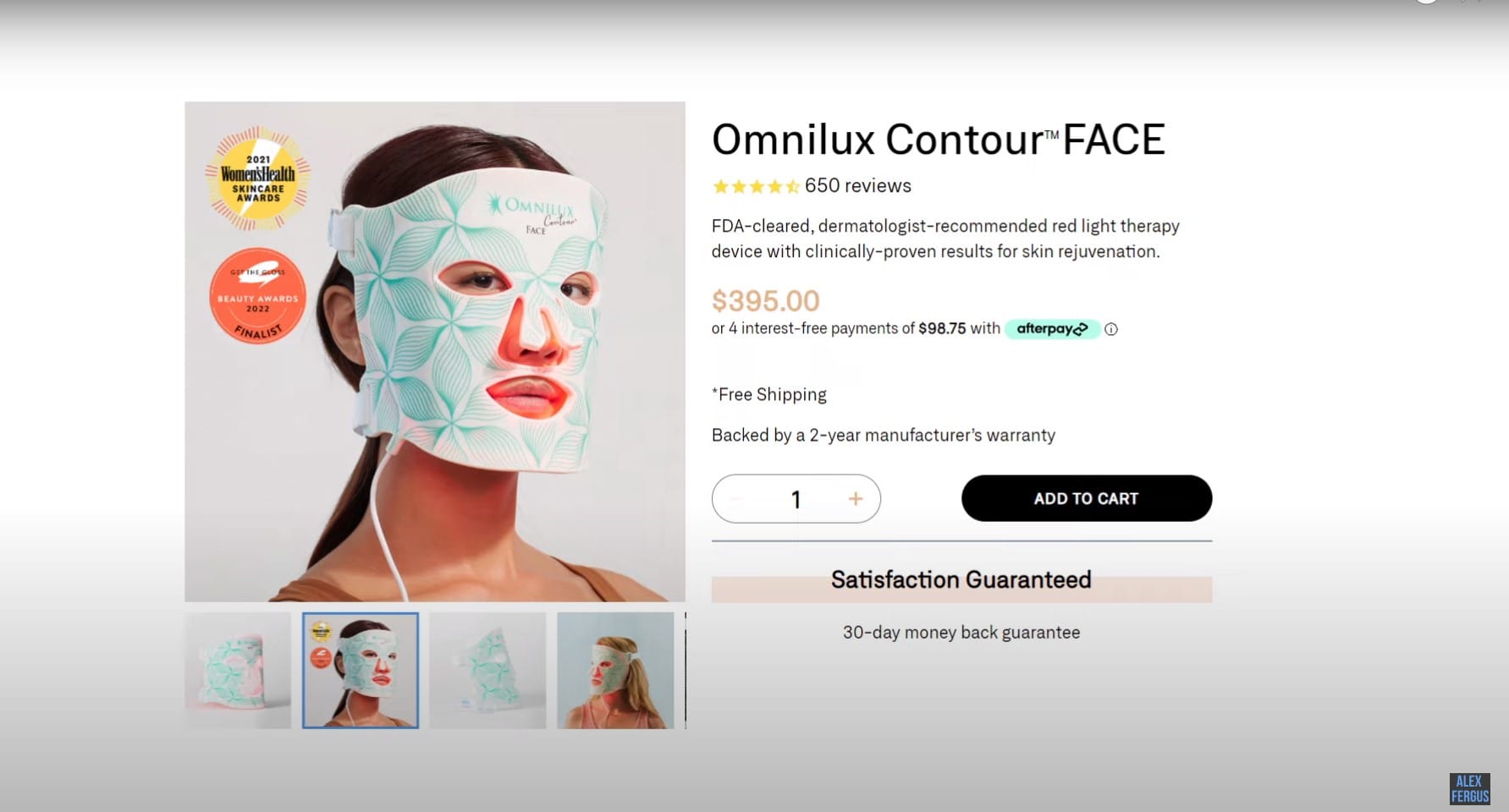
We will discuss the differences between them, and I'll share why you would probably want to get this one instead of the Contour FACE (even if you're a female) because I have done some research into that.
I saw a question on their website asking, "Can women also use Omnilux Men?"
Their official response was: "Yes, women can use Omnilux Men. There is no harm for a woman to use it with the 1072 wavelength."
So there we go. If you are a female, and you are looking at getting either their Omnilux Contour Face for women or their mask for men, you might prefer this one for men which gives you an additional wavelength since they cost the same at this time.
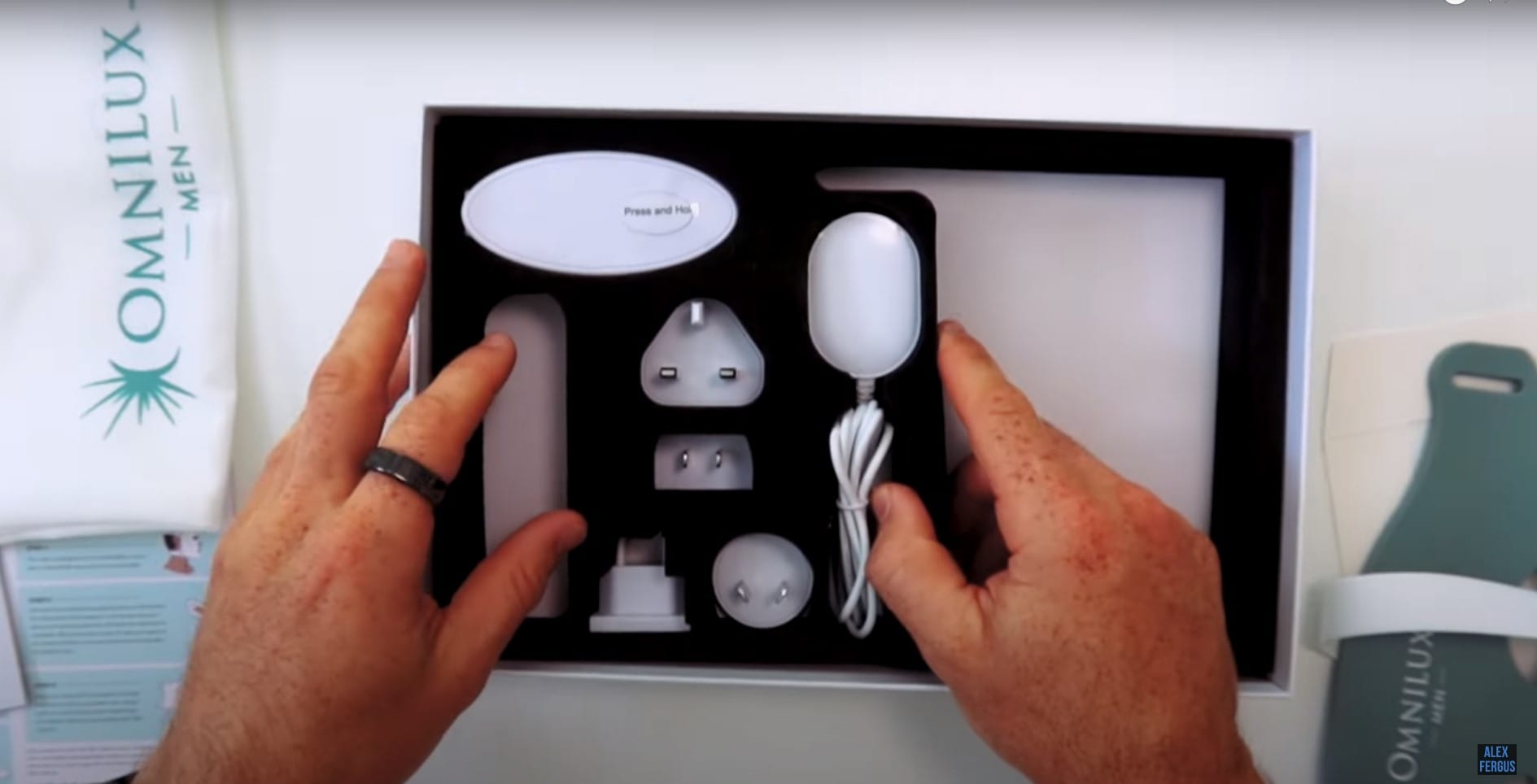
As we saw earlier, there are some additional benefits from that wavelength, so why not? It doesn't look like a masculine product or anything like that, but it does say "Men" on the forehead.
Skincare, Science & Light
So, does it work well? The science behind light therapy is fascinating.

If you are interested in learning more about the benefits of other colors, I made this video: Light Therapy For Skin Health: 8 Amazing Wavelengths.
- The 630nm red light in the Omnilux mask has been shown to stimulate collagen production. This is going to result in smoother looking skin by improving tone and texture. It's also been shown to help with fine lines and wrinkles.
- The 830nm near infrared light has some similar benefits that also help with wound healing and boosting skin firmness and improving its overall texture.
- The 1070nm light that is exclusively available in their Men mask is quite interesting. It's often used for brain health because it is deeper penetrating into the into the skull which is great. But there isn't all that much research about that wavelength around skin health.
Omnilux used 1070nm because they say it is deeper penetrating. Since men's skin is 25% thicker, they added the deep penetrating light, yet women may gain additional benefits from that wavelength as well.
So the science is pretty solid for these three wavelengths. If you head over to the website, you'll see some very promising testimonials with before and after photos on their product page. These masks do work.

Be sure to stay tuned because I'm looking at getting a bunch of LED masks and comparing them across a variety of metrics to try and determine which one is actually the best. I'll be seeing how well they each work, so it should be a great resource for you.
Individual Wavelength Benefits
Let's do a deeper dive into each wavelength in this Omnilux Men mask: 630 nanometer (nm) red light, 830nm near infrared, and 1070nm deeper penetrating near infrared light.
Next, let's see what some of the literature says about the benefits of these wavelengths to see if they are substantiated by scientific studies. I'm going to do this while leaving the mask on.
The red color you're seeing is the 633 nanometer (nm) light. It's not the traditional red light that we see in most panels. Typically, that's 660nm, but many panels do have 630 nanometer light such as the company PlatinumLED that makes BioMAX panels.

Omnilux says 633nm helps with skin pigmentation issues, reduces redness, and improves overall skin tone including collagen production.
My research reading about the scientific studies confirms that 630nm is good at reducing fine lines and wrinkles and helping out with certain skin disorders. It's even been shown to help somewhat with restoring hair regrowth for those who have had hair loss. Rest assured, it does not cause hair to grow just anywhere.
There's some research that 630nm could be beneficial in the treatment of non-melanoma skin cancer. Also there's a little bit of evidence showing 630nm can be beneficial for acne.
On a side note, Omnilux also makes a third mask called Clear.

Omnilux Clear has two wavelengths: 633nm red light plus 415nm blue light to fight acne-forming bacteria in the tiny glands beneath the surface of the skin.
Now, back to the Omnilux Men mask. In addition to the red light, it also has 830nm near-infrared light. So that's more about getting deeper into the skin to support collagen and elastin production. My research shows that 830nm is beneficial as a deeper penetrating light.
There is a lot of evidence showing that the 830nm can help with wound healing and scars. So maybe it could be beneficial if you've got some acne scars or any other form of scars.
Typically, 830nm is for bone repair and to help with deeper benefits such as muscle recovery times after a training session. Those benefits don't seem to be related to the purpose of this mask, yet it may come in handy if the user has any unforeseen issue such as oral or facial surgery or any injury that you want to heal as quickly as possible.
So what about the 1072nm light? Omnilux says that 1072nm has been shown to penetrate even deeper into the tissue and therefore produces a much deeper cellular response in the skin when compared to the 830nm and the 633nm. I agree. That is 100% true.
Men generally have thicker facial skin than women, yet women have thicker skin than men in other places on the body such as the thighs and abdomen. In general, facial skin is typically between 1.5–2mm.

Logically we would conclude that, 1072nm longer wavelengths would be able to penetrate deeper into the cells.
Here's some helpful PubMed data collected from different scientific studies regarding the different wavelengths and their penetration depth that Gembared has on their website:
780-980nm: 63% reaches 2mm
600-700nm up to 1mm
633nm to 1.8mm
650nm to 4.5mm
660nm to 2.0mm
750nm to 5mm
850nm to 2.4mm
900nm to 2.5nm
Omnilux says, "Men have thicker skin due to higher testosterone levels."
If it's all about how deep the wavelength's light and heat can penetrate beneath the skin, couldn't we just use infrared light from a fireplace or sauna. There's more to unpack here though as seen in this graph on the Gembared site.

Low-Level Laser Therapy Database
So, I went and did my own research and pulled up a bunch of studies in the low-level laser therapy database which is absolutely epic! I'll put a link to it below. It has thousands of studies on red light therapy and different wavelengths.
All right, let's have a look at the benefits of the wavelengths in this Omnilux mask. I'm doing a quick search for 1072nm light. It's telling me there are about 20 results.

The first one is about helping Alzheimer's, but we will keep our focus on looking at skin health. Green means the studies found a positive correlation.
The next one is on herpes blisters on the lips and mouth. So they used 1072nm infrared light for the treatment and found that the median duration was only 129 hours compared with 177 hours typically. That is 27% faster healing for that form of herpes which is impressive!
What else does it show? The next study is also about herpes. If you do suffer from that condition, then this mask is going to be great for helping your skin health.
Also, what if study participants didn't only use this wavelength after a skin problem appeared? What would it be like if they were using a device such as this Omnilux mask daily for prevention or twice daily at the first onset of blisters?
How would that improve their overall experience of protecting and maintaining their skin health if they owned a light therapy device with this 1072nm wavelength?
What else does the database tell us?
There's one on immunity of brown worms. We want to keep our focus on skin health, so we won't open that can of worms.
My search was limited to 1072nm wavelength light. However, you could explore further, and research a range of 1060nm to 1080nm light within 8-12nm. I'll be testing this mask with my spectrometer to see exactly what wavelengths it is putting out.
When I search 1070nm light, I get another study about Alzheimer's plus one on Parkinson's. So there's not a ton of evidence in there to show that it's beneficial, but there are a few promising studies regarding skin health.
Wavelength Spectrometer Testing
Now, let's test exactly how much energy is coming off this mask. I've got my spectrometer here, so we'll see if the wavelengths shown on the box are what I measure coming out of the LEDs.
My spectrometer testing device costs a couple thousand dollars. It measures how much light is emitted at different wavelengths. Typically, I measure wavelengths at a six-inch distance. I'm not going to do that with this mask because we're not wearing it at six inches / 15.25cm from the face. Our face is right up against the lights.
So let's turn this mask on first which is easy to do. You just press the button to turn it on, and press it again to turn it off. It will automatically run for 10 minutes then turn off.
There are some indicator lights on this unit which show the battery life. It's designed to give you about 10 sessions from a full charge. What I'm looking for here is firstly what wavelengths exactly are being emitted from the device, and then we want to know precisely how much power it is delivering.
Remember, each LED bulb is has two chips in it, so there are two peaks on the meter showing both 639nm and 830nm therapeutic light wavelengths.
What's interesting is that the peak was actually 628nm, so it's a little bit off the 633nm. I like to see them within three to five nanometers of a company's figure. There is still a ton of 633nm light, but there's a little bit more at 628nm.
That's why when we were looking at the studies before, I don't get too caught up in 1072nm exclusively because you're probably getting light at 1068nm through to 1075nm. When we go to the 830nm range, we've got a peak at 830nm. So that is an exact match.
I just realized this spectrometer device only goes up to 1050nm, so I'm not going to be able to pick up the 1072nm which will also mean the power readings won't take that longer wavelength into consideration in the power output figure which is a bit of a bummer. This is the first time I've come across that wavelength in the products I've tested.
Power Output Testing and Analysis
Next, we're going to test how powerful it is. There is quite a bit of variability. It's a little bit trickier testing a mask like this especially since the 1072nm wavelength doesn't show up because it is beyond the range of my spectrometer, but it still gives you a pretty good idea of how much power is coming out of these LEDs.
The irradiance is the power figure reading of 30.86 milliwatts (mW) right against the surface which is actually quite respectable given that is how it is intended to be used.
For comparison, I measure red light therapy panels at six inches / 15.25cm. With this mask, I'm getting minuscule figures at that distance which is to be expected given that these are not high output LEDs compared to what you would see in most light therapy panels. If you don't know what I'm talking about when I say a panel, here is an image of one so that you can see what I mean.

These panels are seriously high-powered units. There's a lot of cooling fans in there. There are also heat sinks because they put out a lot of heat. There's definitely much more electricity being utilized with the panels to turn that electric power into therapeutic wavelengths.
The Omnilux masks are each powered by a little battery pack. So I know it's not going to be extremely powerful.
However, with those panels you're typically standing 6 to 12 inches / 12.25-30.5cm away, yet you're still getting a really good dose even at that distance.

Now when I test this at six inches, there's hardly any power. However, we're not using it that far away, are we? If I use the testing device right up against it, that's where I was getting those readings in the range of 15 through 30mW that we just saw.
The Mito Red belt is similar since it is worn right up against the body. I think I saw a 35 or a 40mW range on that one which is a little bit more power than this mask.

It had quite a big battery pack and more LEDs with that Mito Red belt. I went a few millimeters just off the top to measure that device.
This mask has similar sort of numbers, so I guess that's kind of the norm for LEDs that are designed to be worn against the skin, so it's all relative to how the product is used.
One perspective to consider is that you may be better off spending your $400 on getting something like tabletop panel such as the ones you see here behind me. I've done heaps of reviews on them all if you want to check any of those out.

With a panel like that, you're getting a ton of light. There's far more energy in one of those panels than in this mask. Of course, masks are right up against the skin, so it doesn't matter as much about having that high power dose.
Naturally, there are other benefits to a mask that is designed to be used for the face exclusively. It's light and portable, so you can move around and do other stuff while using it. You can even pack it in your suitcase.
There's one quick thing I should mention while we're talking about power. Omnilux actually states that their mask puts out 35 milliwatts over centimeters squared (35mW/cm²) which was roughly what I saw there at the specific places of peak output. So our readings match up which is always a good sign.
In addition to longer wavelengths, higher power may also correspond to greater depths.
Going back to the scientific studies referenced on the Gembared site to share this snippet of a quote: "15 Watt 810nm laser to penetrate 2.9% of the power 3cm"
It's good to remember that we are measuring a mask's power irradiance in milliwatts rather than Watts which are 1000 times stronger. So the 15 Watts needed for roughly 3% of the power to reach 3cm / 30mm would be the equivalent of 15000mW.
Again, most of my readings on this mask are around the 15 to 25mW figure because the goal is not to reach 30mm just the 1.5 to 2mm thickness range of the average person's facial skin.
Omnilux mentions the power is being calculated to be the optimal dose for cell stimulation. So you know that's why they've come up with that figure. However, if they had found the optimal figure was 100mW, I don't think they would be able to do it with a mask this thin. I don't think it's technically possible at this time.
We will look at ease of operation next. It's super simple. You strap it on, press the button for a second or two, and away you go.

You put this battery in your pocket, or let it dangle around by your ear if you want, and use it for 10 minutes until it turns off automatically.
You use this mask about four to five times a week. Each session lasts for 10 minutes. They say after about 4 to 6 weeks, you should start seeing results. I will do some before and after photos and share my results here with you later in this article.
Cost, Discount Code, Shipping, Warranty and Trial Period
I'll put a comment below with the latest deals going on.
They do ship to most western countries. You can see all the countries they ship to on their website. It has a two-year warranty and 30-day trial period which is pretty good for an LED mask product (again, click the link for the discount to apply!)
It's the first time I've tested a product from Omnilux. I can tell that it's well designed and well constructed. It's not just done on the cheap, so good on them for investing in creating a quality product.
It's well packaged with good explanations and instructions just as you'd expect from a $400 product.
Comparison Between Two Masks
Now, I usually do a comparison to other products at this part of the review. The only other mask I've tested so far is the Dermabeam mask which is very different in that it was a thick, rigid mask. It almost almost looked like a plastic version of a welding mask.

Now what was interesting with that product is the battery pack and the control panel were built into the the arms that go over the ears. It doesn't have straps, it has plastic temple pieces that rest on the ears. Those power and control components were all built into the temple pieces which was convenient.
However, I think this Omnilux mask is going to have a much longer battery life and higher wattage power output than the Dermabeam mask since the battery was smaller to fit into the temple sides.
The Dermabeam did have multiple color wavelengths, so you could change between greens and purples and blue which is good if you want to treat things such as acne. Remember that the Omnilux Clear mask does have the antibacterial blue light.
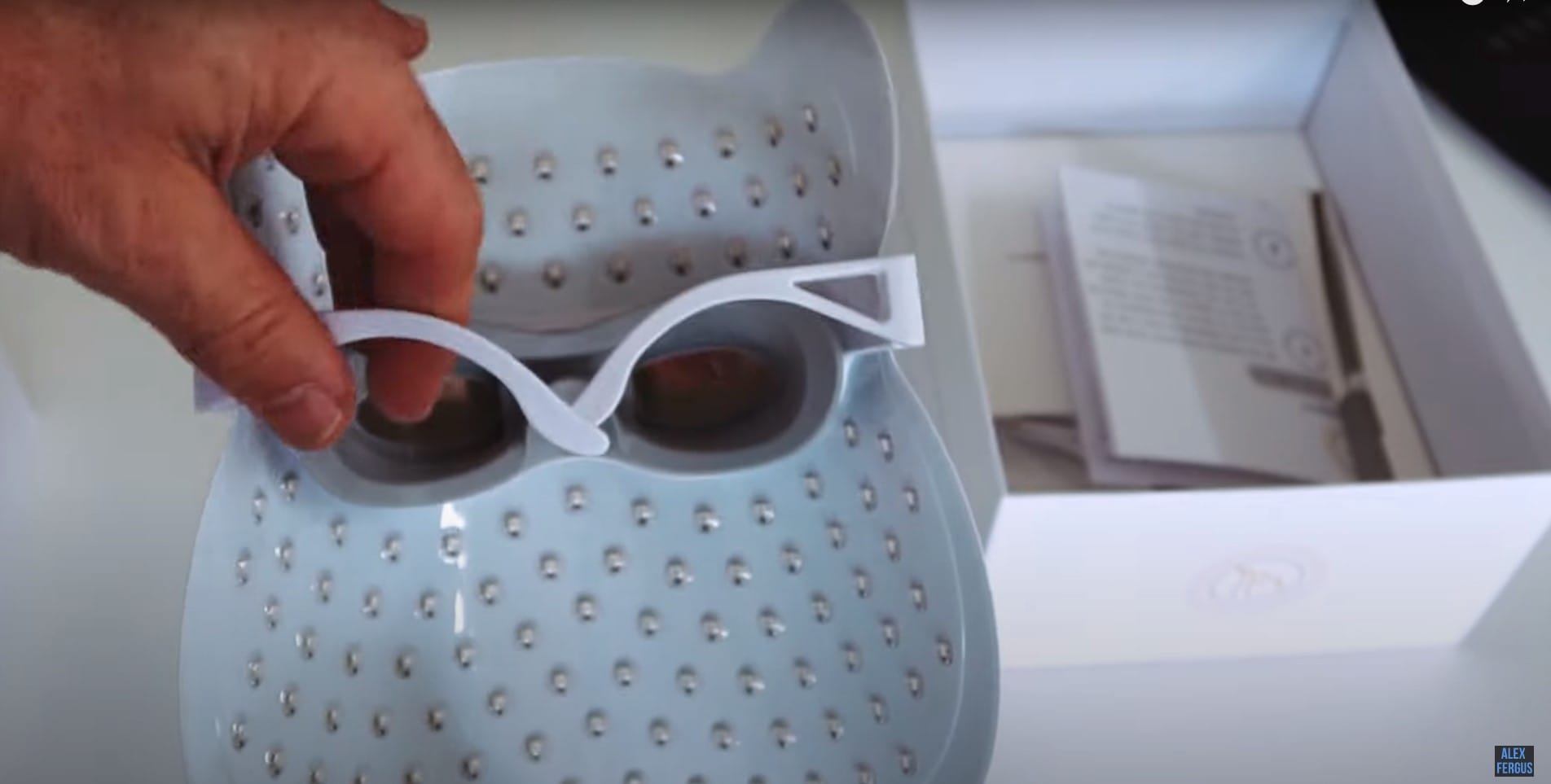
I haven't really looked at many masks yet, but let's discuss the advantages of related products such as a panel.
Masks Vs Panels
Now beside me is the Platinum LED BioMAX 300. This panel here costs $560 US dollars. After you click the BioMax link you'll get a discount code.

It has 100 LEDs. It's quite a solid and heavy panel especially with the stand. It puts out a ton of power. You're getting about 80 milliwatts over centimeters squared at six inches or 12.25cm (80mW/cm².)
Remember, the peak I got in this mask was about 30mW right against the mask. So panels are a whole different ball game when it comes to irradiance power. The light coming off a panel is so bright.
It's a bit more expensive at $659.00 currently. That's up from $629 USD before they added the 1060nm light. With discount code that's generated after you clisk the link you will get 5% off if you use the following link: https://aferg.co/redled which brings their newest version down to $626.
If you're serious about getting one of these masks for your skin health, you should at least compare them to the panels which are all going to be far more powerful.
There are many other options if you are looking for something smaller, thinner and lighter. There are so many different types that each have their own assortment of beneficial wavelengths.
Consider those for comparison and think about how you want to use it. If you don't want to spend that much, you can get some tabletop panels for only $300 to $400 depending on their features.
Panels are simply different from masks. Clearly, you're not going to be vacuuming while you're using a panel. But these are so much more powerful that you only need to use use it for say five minutes, and you don't even have to be right up next to it. Plus, you can even use the panels to target your sore knee, back, chest, or wherever else you want to use it.
I'm not saying one's better than the other. They just serve different purposes. But when you think about it from a performance and power output and even a value perspective, if you know how much money you're spending per therapeutic light milliwatt, then getting a panel is going to give you more bang for your buck. It's going to win in a lot of those categories.
Again a tabletop panel doesn't have the portable compact travel benefits that this mask does. Nor does it give you the freedom to move around that the mask does.
If you are looking for a red light therapy product that is easy to travel with the way this Omnilux mask would be, another great option is the Mito Red Mobile Super.

This smart device has many useful features and currently sells for $349 before applying the discount from my link.
My Experience Using An Omnilux Mask
Alright, I tried it for five and a half weeks, and here's what I found. I did get 12 full sessions out of one charge. So that is quite impressive!
The battery pack really needs a clip on the back. As it is, if you don't have pockets in your shorts there's not really much you can do with it other than let it hang. Now, if you're trying to move around the house and doing some chores while you're using this mask, having the battery dangling is going to be annoying.
Wearing the mask isn't the most pleasant experience. Yes, you can see through it, but it is a little bit tricky. You need to get the angles just right which is not the most ideal.
Again, you're only using it for 10 minutes, so that issue is not a game-changer. I do notice I get a little bit sweaty from wearing it.

It's a combination of the near infrared light plus the fact that this is thick silicone which is not breathable naturally. It's worn straight up against the skin. It wasn't a deal breaker for me, but you may want to keep that in mind.
Considering the cost of the mask, the straps on the back really need a better design. If the straps were elastic, it would probably help since then you could slip it over your head. Instead, you've got to thread it through a hole and then tighten it up. It's not ideal.
If you have been following my content for a while, you know that I used to suffer from sensitive gums.

Red light therapy stopped that sensitivity. However, when I was using this I noticed some of that sensitivity came back while I wasn't using the panels during the testing of this mask.
It may be because the the power is lacking here compared to the panels which I typically use.
There has been research done that looked at exposing half of the body to red light therapy, and they actually found that the other half (the non-exposed half) also benefited from the treatment.
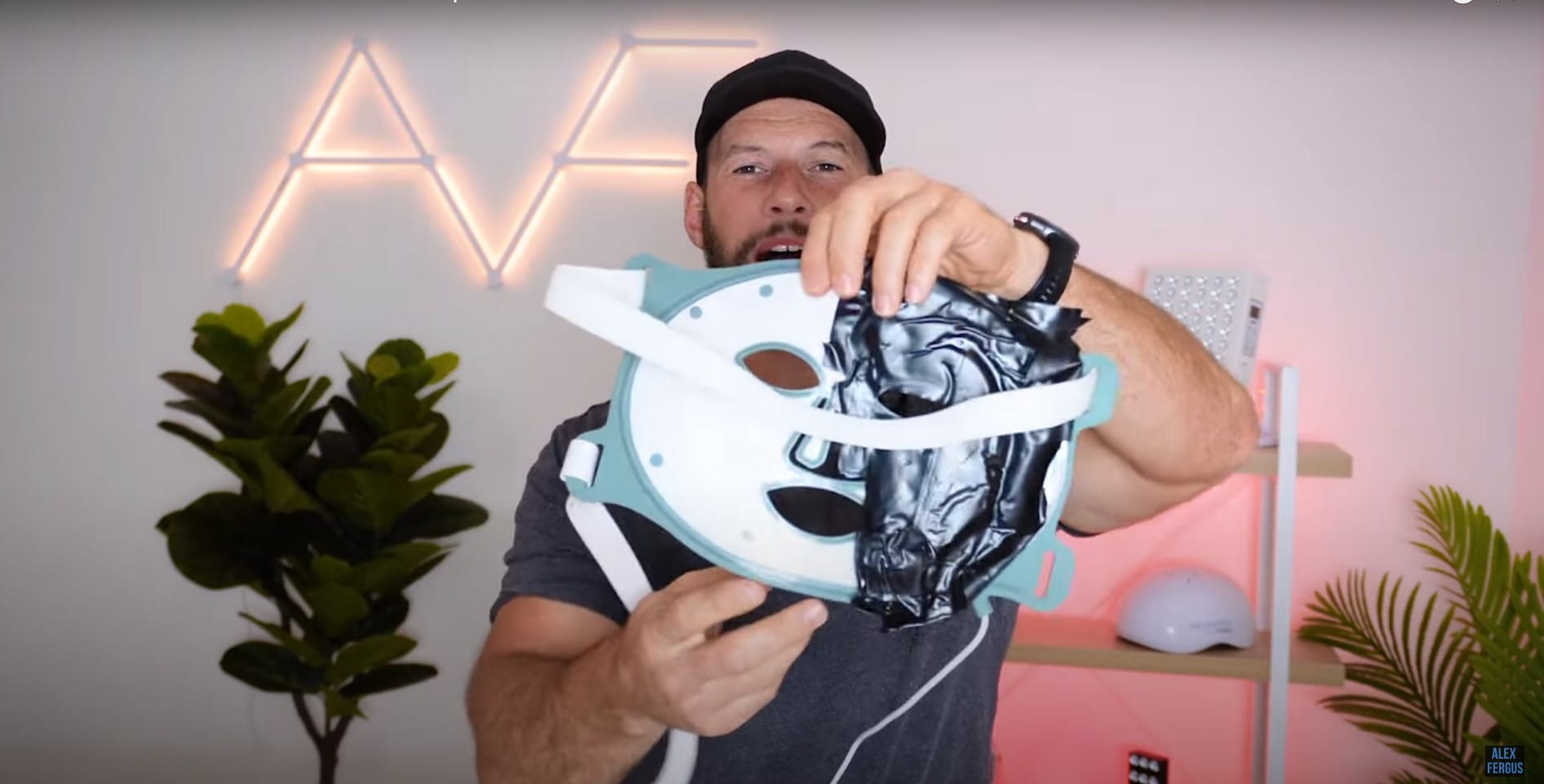
So red light therapy does have body-wide systemic benefits which means that this little experiment of mine isn't going to be perfect.
Before And After Pictures
Okay so, what about my skin? Did it change after the five weeks of using this mask? Well, I'd love to say I noticed a significant transformation, but in all honesty, I don't think there was much change at all.
Now, I've got some before and after photos here. You can see the before on the left and the after on the right. I don't really think there's much change at all which is kind of disappointing.

Studying it closely, I see a little bit of a difference, but I think that may be coming down to unintended variables in lighting and how sharp the focus is.
I was hoping that I would see more dramatic changes in that time period, especially between the side of my face that was treated and the other side that just received vicarious systemic benefits at most but no direct therapeutic light.
Why is this the case? Well, some may argue I didn't use it long enough. Others may say, "Look he's been using red light therapy on his face for six years! You can't expect to see noticeable changes from this mask in just five weeks since it is more of the same in a way."
I stopped using the panels on my face during this experiment time. So, I was really hoping that my skin on the half without the therapeutic light would have worsened in contrast during this experiment.
Maybe the power irradiance (the amount of energy coming from the LED lights in this mask) wasn't enough. On the other hand, for superficial benefits like surface level stuff you don't need that much power.
I crunched the numbers, and with a 10-minute session with this mask, it should be a strong enough dose. Maybe I should have used it more frequently perhaps daily instead of four times a week.
Will I keep using it? No, I won't. It's kind of annoying to use. I'd much rather just use a panel. With the mask, you've got to charge it, the straps were a hassle, and the sweating was not something I experience using panels. I'm not going to bother with it any more.
What am I going to do with it? Well, I'll give it to someone who hasn't been using red light therapy who has some skin issues. I'll let them play with it and take some before and after pics as well. Maybe they'll have some noticeable results.
Should You Buy?
What about you? Should you buy it? Well, we know from the science that red light therapy works. We know from anecdotal reports that it's amazing. My own journey has been insane in terms of benefits.
I even did an experiment in which I stopped using all red light therapy for a month. A lot of unwanted symptoms started coming back into my life during that brief time.
The science is strong around beauty and skin health with the particular wavelengths generated by this device. However, it is a lot of money. As we just saw, I didn't get any additional benefits above and beyond using my panels.
From a value point of view, you're better off buying a red light therapy panel. You're going to get a lot more power along with a larger treatment area. Plus, you can use it on other areas of your body like a sore knee or or a sunburned neck or whatever else you would like to treat.

Not only that, you can get panels with a lot more wavelengths that are easier to use with nice control panels, better warranties, and more. Of course, the main benefit with the panel is you don't have something strapped directly onto your face.
Now, if you are considering a panel instead of a mask, be sure to check out this article The Best Budget-Friendly Red Light Therapy Panel Review where I look at 9 different table top options to determine which one is the best for beauty and skin health.
Finishing Thoughts
You may want to head over to the Omnilux LED website. They have a lot of useful information about their products. If you do want to get one of these, you can save by using my discount link above (the discount is automatically applied when you click the link). I'll put all my discount links below for each product mentioned in this article.
I do appreciate any feedback or comments you have for me. If you have an Omnilux product and you love it (or don't love it), please share your experience with us because I'm sure everyone will benefit from hearing your thoughts as well.
I hope you've enjoyed this review. If you want to see more mask reviews, let me know. And please feel free to share what companies and products you're most interested in having me check out because reviewing masks is new territory for me. Alright, thanks guys!
This Article's Products With Benefits:
- Omnilux Men, Contour, and Clear (click the link for the discount to apply!)
- Mito Red Mobile Super and Mito Red light therapy belt, The discount will automatically apply at checkout if you use that link.
- Dermabeam Mask (code ALEX saves)
- Platinum LED BioMAX 300 (a discount code is generated for you after you click the link!)
Extra! Extra! Read All About It!
✅ The 830nm Wavelength Health Effects Cheat Sheet
✅ Mito Red Mobile Super Review: Feature Rich Red Light
✅ MitoADAPT MIN Vs BioMAX 300: Which Is Better?
✅ Hooga Vs Hooga Pro: Is Premium REALLY Better?
✅ Hooga HG24 4 in 1 Review: The Cheapest Beauty Therapy Light Ever?
Be In The Know With These YouTube Videos
✅ Reviewed: Omnilux Men Mask - Great for Women as Well?
✅ I Tried The Omnilux Mask For 5 Weeks: Surprise?
✅ LED Mask Vs Red Light Therapy Panel: Which Is BEST?
✅ Mito Red Light Belt Review: BETTER Than A Panel?
✅ Mito Red Mobile Super Review: Feature Rich Red Light
✅ PlatinumLED BioMax 300 Review: 6 Wavelengths & More!

